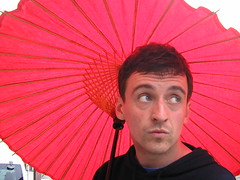Nikko
In the words of these hearty fellows, click pictures for bigitude!
 By thunder, it's difficult to know where to begin...Nikko is a small city north of Tokyo, rich in history and photo-potential. It has a sacred pedigree stretching back to the 8th century, when the priest Shodo Shonin, credited with introducing Buddhism to Japan, founded a number of Temples that bear the name Rinnoji. A legend about him crossing the river Daiyo, borne by no less than two giant serpents, resulted in the construction of Shin-kyo Bashi, the Sacred Bridge. 500 yen to cross...we thought it better just to take pictures.
By thunder, it's difficult to know where to begin...Nikko is a small city north of Tokyo, rich in history and photo-potential. It has a sacred pedigree stretching back to the 8th century, when the priest Shodo Shonin, credited with introducing Buddhism to Japan, founded a number of Temples that bear the name Rinnoji. A legend about him crossing the river Daiyo, borne by no less than two giant serpents, resulted in the construction of Shin-kyo Bashi, the Sacred Bridge. 500 yen to cross...we thought it better just to take pictures.
And yes, this is going to be a "look at my holiday photos!" entry. I make no apology. Below is one of the aforementioned Rinnoji Temples, this one housing three gigantic golden Buddhas (photography is apparently forbidden), themselves considered manifestations of regional Kami.

A momentary break from Temples brought us up a very windy mountain road to a stunning view of Lake Chuzenji and the Kegon waterfall, thus...

...it cleared up later, allowing me to take THIS.

So anyway, back to Temples...after being established as a training ground for Buddhism, Nikko declined into obscurity for a bit, until it was chosen as the site for the mausoleum of Ieyasu, the founder of the Tokugawa Shogunate. It took some 15,000 craftsmen & artisans two years to create the shrine where the famous warlord rests. The style of the place doesn't conform to the Japanese "less is more" ethic, and as a result, it's received some mixed reviews...but I like it.



The place defies my puny mortal efforts to photograph it.



What's amusing (to me at any rate) is that the most famous icon to be associated with this Temple isn't the immensely significant historical character, rather, it's three monkeys.

Yes indeed, this is where the little blighters come from - a mural on one of the buildings depicting the life cycle of the monkey. Souvenier shops abound with the timeless trio, but I didn't buy one, as the damn things are so ubiquitous.
A quieter end of Nikko, merely ten minutes walk from our lovely hotel, is the Gamman-ga-fuchi Abyss, much less threatening than its name suggests.


Running along the course of the Daiyo river is a row of statues depicting Jizo, the patron deity of deceased children. Photo below courtesy of Hayley.

One of the statues midway is called the Bake-Jizo, so called because it mocks travellers who try to count the allegedly uncountable Jizos. I counted roughly seventy-four, my confusion itself seeming to tease me. There were a couple of plinths that, although weren't bearing statues, still had the distinctive red bibs I've seen on many a Buddha whilst here. What denoted a Jizo? What is the real difference between a Buddha and a pile of rocks? That's Zen for you I suppose.
Labels: cool places, culture (shock), fun, I wasn't expecting that, Japan, tourists



7 Comments:
Yes!!! I WAS waiting for this one. What wonderful photos!! Best of all, now I know where the 3 wise monkeys came from. Good old Japan!! By the way, I WANTED to write "Niponese". What is the difference between that and "Japanese"?
Crumbs, that was quick mother...
Nippon and Japan are the same place - the Japanese prounounce it Nihon. The word has been passed around several explorers, traders & the like who pronounce it according to their own language, eventually resulting in "Japan".
Perhaps a pile of rocks indicates a Bhudda post enlightenment?
The pictures brought back lots of lovely memories - I love Nikko. Although I seem to remember that every time I went there they were restoring the bridge and so I only ever saw a picture of it rather than the actual thing (not quite the same).
So, thanks for the trip down memory lane!
The English "Japan" is supposed to have origin in "Cipangu," the name Marco Polo used to transcribe "Ribenguo" (that sounds more like Zhirpenguo), which is the Mandarin pronunciation of "Nippon Koku" (State of Japan).
Cipangu later became Italian "Giappone" then French/Spanish "Japon" and Germanic "Japan."
While most Japanese call their own country "Nihon," nationalists love to call it "Nippon," which sounds full of vigor. The Japanese government wanted the world to use Nippon and Nipponese instead of Japan and Japanese during the WW2.
Wonderful pictures of the temples! I love browsing through pictures from around the world on blogs. Those monkeys look like lawn ornaments stolen from a lawn in Florida. Odd...
I remember that place. i don't remember it looking that good. you take some fine photos mr the man. And as always i'm really impressed with your knowledge of the places you go. I go, snap a few photos, say "wow that was pretty" and leave and wait untill you visit the place to find out about it:P
Keep it up! Gambate! Still gona have to do this beer thing some time.
Cheers!
Post a Comment
<< Home